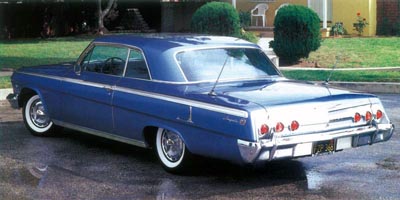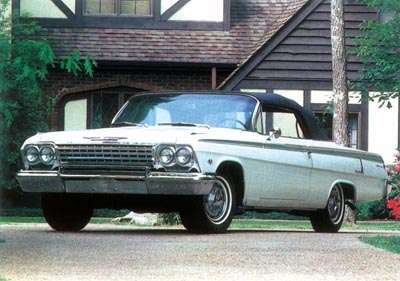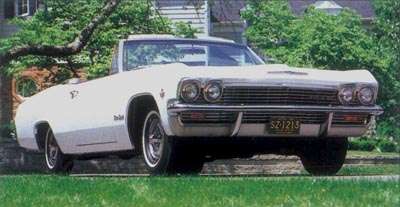Regular 1962-1965 Chevrolet Impalas sold well too, in part because Chevrolet had gone to some lengths to broaden the line's appeal.

The 1962 Impala face-lift lent this two-door hardtop
a squarer, more august appearance.
|
The two-door sedan didn't return for 1962, but Impala script supplanted the Nomad name atop the wagon roster. Two-door hardtops gained a new roof with the crisp appearance of a raised convertible top, a look that would last through 1964.
No less than six engines were available to power the sedans, coupes, convertibles, and wagons that carried the Impala badge, ranging from the trusty inline-six, to three versions of the small-block V-8 (two of which were a new 327-cid job), to a pair of fire-breathing 409s that, as before, triggered some mandatory chassis beef-ups when ordered.
What was Impala's magic formula? Style was paramount, of course.
Throughout the early 1960s, Chevrolet's basic body designs became increasingly subtle, while the bright trim that was part of the Impala package added more than a touch of luxury to the look. The same pattern was followed in the interiors, where the best materials and equipment Chevrolet had to offer were displayed. In short, the Impala was on its way to becoming a kind of junior-grade Cadillac, which, for both the company and its customers, was just fine.

This 1962 Impala SS ragtop has the 327-cid
small-block V-8 that bowed for that year.
|
But even those buyers who prized Impalas for their increasing comfort and opulence were well aware of the line's performance heritage. The 409 remained available through the start of 1965 model-year production (it came in three horsepower levels in 1963-1964), the SS package was still a popular choice, and the crafty folks at the factory had at least one additional ace up their sleeves.
Said ace appeared at the 1963 running of the Daytona 500. Factory representatives were reluctant to talk about what was under the hood of a select few Chevrolets that came to race in Florida that spring, but NASCAR's requirement that engine size be spelled out on the cars' hoods gave the secret away: Whatever was installed in these Impalas displaced 427 cubic inches.
Variously called the "Porcupine Head" engine (for its angled valves) or simply the "Mystery Motor," it was obviously something special. Officially, the engine -- called Z-11 for ordering purposes -- was rated at 430 bhp, but this was considered by many to be a 70-bhp understatement. Not many people found out; fewer than 60 Z-11 Impalas were built before General Motors brass reminded Chevrolet management of the corporate no-racing policy and shut things down. But it would be back.

A revised grille, straightened A-pillars, and
horizontal body creases defined the 1963 Impala.
|
As it had in 1961, the Impala reached another peak in 1965. Once again, it was a combination of speed and style that brought the fans flocking to dealerships.
Under General Motors design chief Bill Mitchell, Earl's successor, Chevrolet stylists produced an exciting shape for the 1965s; long, flowing, simple, and beautifully proportioned. This disciplined design proved to be equally satisfactory to customers looking for either a luxury or performance car; more than 1 million Impala and SS buyers confirmed that.
The 1965 Chevrolet was more than a reskinning job. A new full-length perimeter frame with four cross-members replaced the X-type unit, and both front and rear suspensions were revised to improve ride and handling. A wider track front and rear aided stability as well.

The loftiest four-door in the 1964 Impala series was
the hardtop sedan, which started at about $2,800.
|
Initially, engine choices were similar to those offered in previous years, though power output for the hottest 409 (no longer available with dual quads) was a comparatively mild 400 bhp before being dropped altogether in mid-year.
Few mourned the 409's demise for the simple reason that a new engine took its place. This 396-cid V-8 was derived from the 1963 "Mystery Motor" and was available in two states of tune.
The more common version, rated at 325 bhp, was available with either a four-speed manual transmission or a new three-speed Turbo Hydra-Matic. Its more powerful brother developed a full 100 bhp more, and was essentially a racing engine tamed slightly for the street, having a forged crankshaft, solid valve lifters, a larger four-barrel carburetor, and higher compression ratio.
Even the six got a shakeup. At mid-year, a 250-cid inline unit was introduced as an upgrade from the 230-cube six installed since 1963.
By now, every body style Chevrolet offered in its full-size lineup could be had as an Impala, save for the two-door sedan. Those desiring an SS still had to be satisfied with a hardtop coupe or convertible. But there was a new trim package for Impala four-door hardtops, one that hinted at the future: It was called Caprice.

At $3,212 to start, a V-8 Impala SS convertible was
the priciest car to wear the Impala badge.
|
After 1965, Impala sales began to soften. For 1966, Chevrolet made the Caprice a three-car series rather than a version of one Impala, and this became the division's luxury leader.
On the performance front, the smaller and lighter Chevelle was grabbing the headlines, all the more so after the factory began stuffing the 396 into it. With demand decreasing, Chevrolet naturally cut down the number of powerplant choices for the Impala SS; in the end, the 1969 SS was available only with a 427-cid V-8, an enlargement of the 396 introduced in 1966.
The Impala name did continue on, but the magic had gone. Yes, there was a big engine available for a number of years after 1969, by now a 454-cid V-8, but increasingly stringent emission-control regulations gradually sapped its strength and many buyers were abandoning full-size rear-wheel-drive cars anyway.
The name finally vanished in 1985. A revival of sorts came in 1994, when Chevrolet produced a four-door Caprice with vastly improved suspension, a 260-bhp V-8, and distinctive exterior trim. Logically, this big, fast, stylish, and reasonably priced hot rod for the 1990s was called the Impala SS. Sadly, the new SS lasted only until 1996, when Chevrolet abandoned production of large rear-drive cars altogether.
Regardless of how good the latest front-drive car to wear Impala badges may be in terms of safety and value, the 1996 SS was the end of the "real" Impala story, a final blip on a radar screen that had displayed its last strong images of rowdy V-8 performance and extroverted styling some 27 years before.
For models, prices, and production numbers for the 1958-1965 Chevrolet Impala, continue on to the next page.
For more information on cars, see:


















